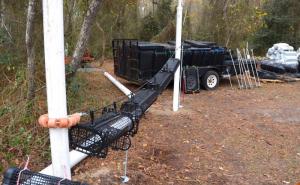It’s a family affair for Delaware Cultured Seafood
At the conclusion of a busy day, Delaware Cultured Seafood’s Mark Casey was chowing down on ham and cheese sandwiches, and what was left of uneaten oysters.
“We used to look forward to our weekends, but now we work harder on the weekends than we do at our regular jobs,” said Casey, laughing, knowing that as soon as he and the family finished those sandwiches it would be time to lock up shop and head back to the real world. Sitting around the table were his wife Lori, daughter Jennifer Hott, son-in-law Brent Hott, son Dan and girlfriend Hannah Stoughton; and Casey’s longtime friend Alex Bourdon, who was there to help. “Everyone here has a full-time job.”
Located off the Indian River, at the end of Warrick Road, east of Millsboro, Casey is part of the family-run Delaware Cultured Seafood, which is attempting to make a go of oyster harvesting under Delaware’s new aquaculture program. Dewey’s Chris Redefer may have been the program’s first person to grow oysters for commercial consumption, but Delaware Cultured Seafood was the first company awarded an aquaculture nursery permit.
The Casey company can trace its aquaculture lineage back generations. Lori is from the Hudson family that dots the river’s edge between Delaware Cultured Seafood and Millsboro. Her great-great-grandfather, James Henry Hudson, moved to Possum Point in 1945. “He used to tong this same area,” said Mark.
More recently, through the Center for the Inland Bays’ oyster gardening program, the Caseys have been growing oysters for years near Bethany to help clean the water of the bays.
Prior to the quick family meal, Brent Hott took the Cape Gazette on a tour of the nursery. He said his in-laws bought the property as a retirement home a few years ago, but with its riverfront location it made perfect sense to open up shop.
The operation includes a seed-growing shed with an upweller unit where spat of different sizes begin their growing. There’s a large oyster tumbler, there’s piles of hexagonal cages, floating bags tied to one side of the dock, and a floating upweller system tied to the other side of the dock. In many ways it’s a smaller version of the operation of Hoopers Island Oyster Company, which provided fellow shellfish grower Chris Redefer with his spat.
“We’re there every week,” said Hott of Hoopers Island.
One difference between Delaware Cultured and Hoopers Island is the Indian River business has an onsite design center where the team is creating equipment specifically for Delaware’s environment that also meets state standards.
Hott proudly shows off a floating post that rises and falls with the tide, but also rises and falls as ice moves in during the winter. He shows off another post design where hexagonal cages have buoys that keep the cages entirely submerged, but at the top of the water.
It’s all about helping the farmers, Hott said.
Hott is also using modern technology – drones – to help farmers be more efficient. He said the drones can be used to check lines, algae growth on cages and other problems, allowing farmers to save time and energy.
In addition to the nursery, Delaware Cultured Seafood plans to grow its own oysters. Hott said the state is processing the application for their Inland Bays acreage, and he said he hopes to have their oysters on the market by early spring 2019. He said the spats they grew and then sold to other farmers have done unexpectedly well, speculating it was because the Inland Bays and surrounding waters have a lot of nutrients.
“It was a busy, busy summer,” he said.
Delaware Cultured Seafood has two trademarks pending for its oysters – Delaware Salts and Blue Hen Oysters. Hott said the Delaware Salts will be grown in Rehoboth Bay where the salinity is 26 parts per million, while the Blue Hens will be grown in the Indian River were the salinity is 17 parts per million.
“We’re trying to set the baseline for what people should expect when they order a Delaware oyster,” Hott said.
Right now, Mark said, the family hopes that at some point, this is more than a paying hobby. Everybody in this room sleeps in this house when working, he said.
“Maybe someday we can build another place out here,” Mark said with an optimistic smile.





























































